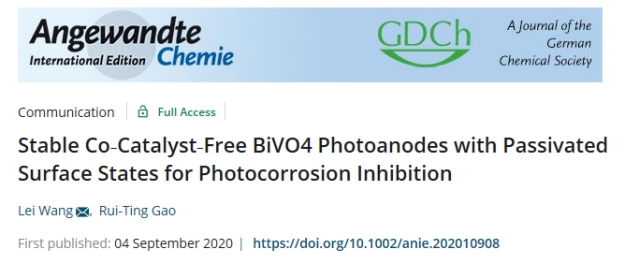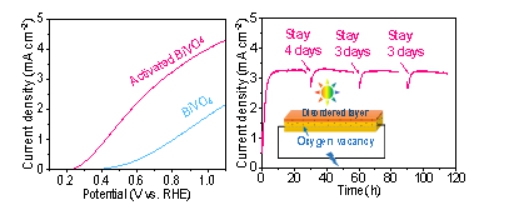Recently the project team headed by Research Fellow Wang Lei made new progress in the research of the resistance of semiconductor against photo-corrosion by publishing a thesis entitled Stable Co-Catalyst-Free BiVO4 Photoanodes with Passivated Surface States for Photocorrosion Inhibition in Angew. Chem. Int. Ed. (https://onlinelibrary.wiley.com/doi/10.1002/anie.202010908), with IMU as the organization of the first author and the corresponding author, Gao Ruiting, Master Degree candidate enrolled in 2019 by IMU as the first author, and Research Fellow Wang Lei as the corresponding author.

Semiconductor BiVO4 is one of the major materials used in the field of photo-electrocatalytic (PEC) technology due to its appropriate width of band gap of 2.4 eV, excellent property of light absorption and appropriate conduction band position for water oxidation under low electric potential. However, the combination of the surface and bulk of BiVO4 material severely impairs the transmission of photo charge and makes the PEC properties lower than the theoretical values; meanwhile the photo-corrosion is also influenced so that it cannot be used for long-term water-splitting reaction. The usual practice is to apply surface cocatalyst for modification to improve the charge separation efficiency of the semiconductor, inhibit the recombination of the charges and accelerate the surface reaction dynamics. The project team of Research Fellow Wang Lei reported for the first time to effectively improve the activity and stability of BiVO4 by improving the material preparation technology and adopting the test method of constant potential photoanodes. BiVO4 without the modification of co-catalyst acquires the photocurrent of 4.60 mA cm-2 under the voltage of .23 VRHE.. More significantly, the semiconductor reaches a stability of 100 hours in intermittent tests and demonstrates an extraordinarily high self-healing capacity. The results of electrochemical tests show that the oxygen vacancy and the assisting effect of passivation layer effectively decrease the electron-hole combination of the semiconductor, improve the surface water oxidation dynamics and further inhibit photo-corrosion.

The above project was sponsored by the National Natural Science Foundation of China (51802320, 21965024) and the Talents Start-up Foundation of IMU (21300-5195102). This is the second time the project team published a thesis in the same journal, the first time in January 2020.
A brief introduction to the corresponding author: Wang Lei, Research Fellow employed on Post B1 under the Steed Program, graduated from University of Science and Technology Beijing in 2010 with a doctorate in in Hylology; awarded doctorate by the National Institute for Material Science, Japan under a joint PhD program from 2007 to 2010; working under postdoctoral programs from 2010 to 2016 in Western University, Canada and Friedrich-Alexander-Universität Erlangen-Nürnberg, Germany; working in Lanzhou Institute of Chemical Physics of the Academy of Sciences of China from 2016 to 2018; working independently in the College of Chemistry and Chemical Engineering of IMU since December 2018 to this day; selected into the Program for Grassland Elites and Program for Cultivating Outstanding Youths of Inner Mongolia. Since its establishment in January 2019, the research team has published 8 theses with IMU as the first organization collected by SCI system, including 2 in Angew. Chem. Int. Ed., 4 in ACS Catal., J. Mater. Chem. A and ACS Appl. Mater. Interface.

